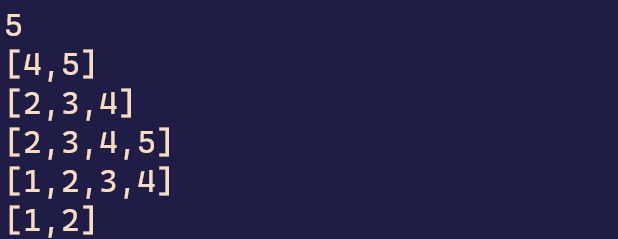这篇文章主要介绍了C# 如何使用 Index 和 Range 简化集合操作,帮助大家更好的理解和学习使用c#,感兴趣的朋友可以了解下
Intro
有的语言数组的索引值是支持负数的,表示从后向前索引,比如:arr[-1]
从 C# 8 开始,C# 支持了数组的反向 Index,和 Range 操作,反向 Index 类似于其他语言中的负索引值,但其实是由编译器帮我们做了一个转换,Range 使得我们对数组截取某一部分的操作会非常简单,下面来看一下如何使用吧
Sample
使用 ^ 可以从集合的最后开始索引元素,如果从数组的最后开始索引元素,最后一个元素应该是 1 而不是0如: arr[^1]
使用 .. 可以基于某个数组截取集合中的某一段创建一个新的数组,比如 var newArray = array[1..^1],再来看一下下面的示例吧
int[] someArray = new int[5] { 1, 2, 3, 4, 5 };
int lastElement = someArray[^1]; // lastElement = 5
lastElement.Dump();
someArray[3..5].Dump();
someArray[1..^1].Dump();
someArray[1..].Dump();
someArray[..^1].Dump();
someArray[..2].Dump();输出结果如下:

Index
那么它是如何实现的呢,索引值引入了一个新的数据结构 System.Index,当你使用 ^ 运算符的时候,实际转换成了 Index。
Index:
public readonly struct Index : IEquatable<Index>
{
public Index(int value, bool fromEnd = false);
/// <summary>Create an Index pointing at first element.</summary>
public static Index Start => new Index(0);
/// <summary>Create an Index pointing at beyond last element.</summary>
public static Index End => new Index(~0);
//
// Summary:
// Gets a value that indicates whether the index is from the start or the end.
//
// Returns:
// true if the Index is from the end; otherwise, false.
public bool IsFromEnd { get; }
//
// Summary:
// Gets the index value.
//
// Returns:
// The index value.
public int Value { get; }
//
// Summary:
// Creates an System.Index from the end of a collection at a specified index position.
//
// Parameters:
// value:
// The index value from the end of a collection.
//
// Returns:
// The Index value.
public static Index FromEnd(int value);
//
// Summary:
// Create an System.Index from the specified index at the start of a collection.
//
// Parameters:
// value:
// The index position from the start of a collection.
//
// Returns:
// The Index value.
public static Index FromStart(int value);
//
// Summary:
// Returns a value that indicates whether the current object is equal to another
// System.Index object.
//
// Parameters:
// other:
// The object to compare with this instance.
//
// Returns:
// true if the current Index object is equal to other; false otherwise.
public bool Equals(Index other);
//
// Summary:
// Calculates the offset from the start of the collection using the given collection length.
//
// Parameters:
// length:
// The length of the collection that the Index will be used with. Must be a positive value.
//
// Returns:
// The offset.
public int GetOffset(int length);
//
// Summary:
// Converts integer number to an Index.
//
// Parameters:
// value:
// The integer to convert.
//
// Returns:
// An Index representing the integer.
public static implicit operator Index(int value);
}如果想要自己自定义的集合支持 Index 这种从数组最后索引的特性,只需要加一个类型是 Index 的索引器就可以了,正向索引也是支持的,int 会自动隐式转换为 Index,除了显示的增加 Index 索引器之外,还可以隐式支持,实现一个 int Count {get;} 的属性(属性名叫 Length 也可以),在实现一个 int 类型的索引器就可以了
写一个简单的小示例:
private class TestCollection
{
public IList<int> Data { get; init; }
public int Count => Data.Count;
public int this[int index] => Data[index];
//public int this[Index index] => Data[index.GetOffset(Data.Count)];
}
var array = new TestCollection()
{
Data = new[] { 1, 2, 3 }
};
Console.WriteLine(array[^1]);
Console.WriteLine(array[1]);Range
Range 是在 Index 的基础上实现的,Range 需要两个 Index 来指定开始和结束
public readonly struct Range : IEquatable<Range>
{
/// <summary>Represent the inclusive start index of the Range.</summary>
public Index Start { get; }
/// <summary>Represent the exclusive end index of the Range.</summary>
public Index End { get; }
/// <summary>Construct a Range object using the start and end indexes.</summary>
/// <param name="start">Represent the inclusive start index of the range.</param>
/// <param name="end">Represent the exclusive end index of the range.</param>
public Range(Index start, Index end)
{
Start = start;
End = end;
}
/// <summary>Create a Range object starting from start index to the end of the collection.</summary>
public static Range StartAt(Index start) => new Range(start, Index.End);
/// <summary>Create a Range object starting from first element in the collection to the end Index.</summary>
public static Range EndAt(Index end) => new Range(Index.Start, end);
/// <summary>Create a Range object starting from first element to the end.</summary>
public static Range All => new Range(Index.Start, Index.End);
/// <summary>Calculate the start offset and length of range object using a collection length.</summary>
/// <param name="length">The length of the collection that the range will be used with. length has to be a positive value.</param>
/// <remarks>
/// For performance reason, we don't validate the input length parameter against negative values.
/// It is expected Range will be used with collections which always have non negative length/count.
/// We validate the range is inside the length scope though.
/// </remarks>
public (int Offset, int Length) GetOffsetAndLength(int length);
}如何在自己的类中支持 Range 呢?
一种方式是自己直接实现一个类型是 Range 的索引器
另外一种方式是隐式实现,在自定义类中添加一个 Count 属性,然后实现一个 Slice 方法,Slice 方法有两个 int 类型的参数,第一个参数表示 offset,第二个参数表示 length
来看下面这个示例吧,还是刚才那个类,我们支持一下 Range:
private class TestCollection
{
public IList<int> Data { get; init; }
//public int[] this[Range range]
//{
// get
// {
// var rangeInfo = range.GetOffsetAndLength(Data.Count);
// return Data.Skip(rangeInfo.Offset).Take(rangeInfo.Length).ToArray();
// }
/本文标题为:C# 如何使用 Index 和 Range 简化集合操作


基础教程推荐
- 首先创建代码,多对多,关联表中的附加字段 2022-01-01
- 如何动态获取文本框中datagridview列的总和 2022-01-01
- 是否可以在 asp classic 和 asp.net 之间共享会话状态 2022-01-01
- 经典 Asp 中的 ResolveUrl/Url.Content 等效项 2022-01-01
- 从 VS 2017 .NET Core 项目的发布目录中排除文件 2022-01-01
- 全局 ASAX - 获取服务器名称 2022-01-01
- 在 VS2010 中的 Post Build 事件中将 bin 文件复制到物 2022-01-01
- 错误“此流不支持搜索操作"在 C# 中 2022-01-01
- JSON.NET 中基于属性的类型解析 2022-01-01
- 将事件 TextChanged 分配给表单中的所有文本框 2022-01-01

















